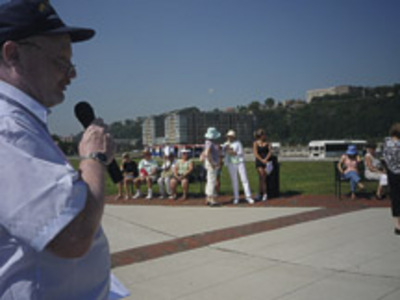More than 50 observers waited by the entrance of the lobby of the New York Waterway Ferry terminal two weeks ago to take part in a tour of Weehawken’s waterfront, complete with historical anecdotes. The tour was sponsored by the Hudson River Waterfront Conservancy, a non-profit organization formed in 1988 to protect the public’s access to the waterfront by keeping an eye on the nearby construction.
Ultimately, the vision of the nine-member organization is to see an open, uninterrupted walkway built from Bayonne Bridge to the Palisades Interstate Park, near the George Washington Bridge. By state law, developers along the Hudson River are required to contribute a piece of the walkway.
Willie Demontreux , a captain in the North Hudson Regional Fire Department and member of the Weehawken Historical Commission, acted as guide for the tour while the Waterfront Conservancy provided a 22-page booklet to participants with pictures of the sites from years before.
Along the way
Sights throughout the tour included the spot where the West Shore Pier 7 used to be along the town’s waterfront near the border of West New York. The Pier was built in 1905 and had a capacity for 2 million bushels of cargo.
Another site was the spot where the world’s largest passenger elevator used to be. Originally opened for service by the Otis Elevator Company in 1891, it stood 197 ft. tall and each of the three cabled cars could hold 400 passengers. Demontreux said the elevator would take people to the old El Dorado Amusement Park that is no longer in existence, but was situated where the current Weehawken High School stands today. People also used the elevator to get to the Guttenberg race track.
“You have to work to protect these resources.” – Helen Manogue, president of the Hudson River Waterfront Conservancy.
________
Weehawken’s dueling grounds were the location of choice for many after New York State made it illegal to duel. Though also illegal in New Jersey, the laws concerning dueling were lax enough where New Yorkers would prefer to cross the river and meet at points such as Weehawken.
Waterfront access
If there was one message from the Waterfront Conservancy to the general public, it was: “Come and use the walkway.” Waterfront Conservancy President Helen Manogue stressed that point, then went on to say that although there was much history that took place near the waterfront areas of Weehawken, a lot of those same areas went without public access for over 100 years.
“We forget that we were very industrial in Hudson County,” said Manogue. “We’re [here] to help the state to complete the walkway. You have to work to protect these resources.”
At the end of the tour, the group made a stop at the Harbor Bar inside the Sheraton Hotel, where the Conservancy treated participants to air-conditioning and a non-alcoholic drink. Manogue thanked Demontreux, Conservancy Board Member Donald Stitzenberg, Mayor Richard Turner, Donna Daly from Weehawken’s Recreation Department, and Laura Sherman from the Weehawken Historical Commission.
To learn more about the Hudson River Waterfront Conservancy, visit their website at: www.hudsonriverwaterfront.org.
Melissa Rappaport may be reached at mrappaport@hudsonreporter.com
